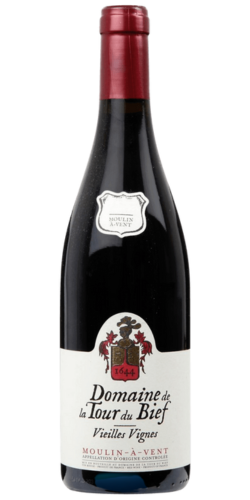
Our Rating

Beaujolais
Gamay
Beaujolais wines are sometimes referred to as Burgundy’s “other red wine”. Most wine drinkers are familiar with the quality of Burgundy’s famous Pinot Noirs and Chardonnays – wines that can cost thousands of dollars per bottle, and whose demand makes them almost impossible to get a hold of. But Burgundy also produces another famous wine: Beaujolais, which is made from Gamay grapes.
Whether you want to call these wines Gamay from Burgundy, Beaujolais, or Beaujolais from Burgundy, one thing remains clear: these wines deserve more attention, and this bottle of 2019 Domaine de la Tour du Bief, Moulin-à-Vent, (Gamay) Beaujolais, Burgundy, France, is no exception.
Let’s dig a little deeper into what makes this bottle so special, and why we gave it a solid 90 point score.
To say that the Domaine de la Tour du Bief estate is historic is an understatement. While it’s unclear when exactly the vineyard land was first planted to grapes, according to Ian Cauble, MS, of SommSelect, and from whom we purchased this wine, the vineyard goes back to at least the 17th century.
Today, the 34 acre vineyard is composed of two main parcels, “la Tour du Bief” and “la Rochelle”. The Gamay vines in this vineyard are ancient vines, with most over seventy years old, and a handful just over a hundred years old. Like most heritage vines, these produce an exceptionally low yield of fruit, but the fruit they do produce is more concentrated than their younger, more productive counterparts.
Winemakers have a certain respect for these old vines, and if you look closely at the label on the 2019 Domaine de la Tour du Bief, Moulin-à-Vent, Beaujolais, you’ll see ‘vielles vignes’, which translates to ‘old vines’.
If you have the chance to visit the Moulin-à-Vent vineyards, the first thing you’ll notice is the 15th-century windmill overlooking the neat rows of grapes, and for which the vineyard is named. The second thing you’ll notice is the beautiful pink soil, which is a mix of pink granite and quartz.
The soil in Moulin-à-Vent isn’t just unique for its eye-catching color and composition, it’s unique for its manganese content. According to Flatiron Wines, low levels of manganese in soil reduces a vine’s ability to produce grapes; however, this reduced yield gives the grapes that are produced more concentrated characteristics – similar to the way a vine’s age also reduces the yield.
When unique soil content and vine age come together, you get Gamay grapes of incredible complexity and structure. It’s this defined structure, and noticeable, but not overt, tannins, that give Moulin-à-Vent wines the ability to age for many, many years. In fact, it’s not uncommon for the best of the very best Moulin-à-Vent Beaujolais wines to age thirty, forty, even fifty years!
What’s interesting about cellared Beaujolais, is that the more time they spend aging, the more they resemble Burgundian pinot noirs.
Even within a specific wine region, quality among producers can vary significantly. With this in mind, Beaujolais wines fall into three categories: Cru Beaujolais, Beaujolais Villages AOP, Beaujolais AOP, with Cru Beaujolais being the highest quality.
Within Beaujolais, there are 10 Cru-level appellations:
Each appellation is special in its own right and has distinct characteristics that make it unique, one of which is the body of the wine. As a rule of thumb, Juliénas, Saint-Amour, Côte de Brouilly, and Brouilly, produce thinner, light-bodied Gamays.
Régnié, Chiroubles, and Fleurie produce medium-bodied Gamay wines. And, the wines of Moulin-à-Vent, their equally famous sister vineyards to the south in Morgon, and Chénas produce bolder wines, if not more memorable ones.
Okay, time for the good stuff, the tasting notes!
Today, there is a trend toward drinking Gamay that is young, acidic, bright, fresh, and, perhaps the buzziest Gamay tasting note of all, ‘crunchy’. These are wines that were intended to be enjoyed young, and not cellared.
If you approach the 2019 Domaine de la Tour du Bief, Moulin-à-Vent, (Gamay) Beaujolais with that frame of mind, you’ll be in for a surprise – a delicious surprise, but a surprise nonetheless. This is not a bright, acidic Gamay.
Rather, a medium-bodied, if not slightly bold Gamay, with dark fruit aromas, a hint of spice, and nice earth tones. Subtle notes of blackberry and spice are immediately apparent, and the finish is extremely satisfying. You may also pick up the sensation of dark cherry, and dried pitted red fruits.
To truly enjoy this bottle, give it 30 to 45-minutes to decant. It benefits from really opening up, the extra time decanting will change the entire profile on the palate.
This Gamay is sold exclusively by SommSelect (our favorite wine club/retailer) and is just $32 a bottle. For a wine that comes from a historic “Grand Cru” site, it’s hard to believe that a wine this good can be purchased for this price.
France
Beaujolais
Gamay
13%
Jean-Jacques Parinet
30-45 Minutes
Now-2026
Domaine de la Tour du Bief


All things wine, and food you could ever need or want — straight to your email!